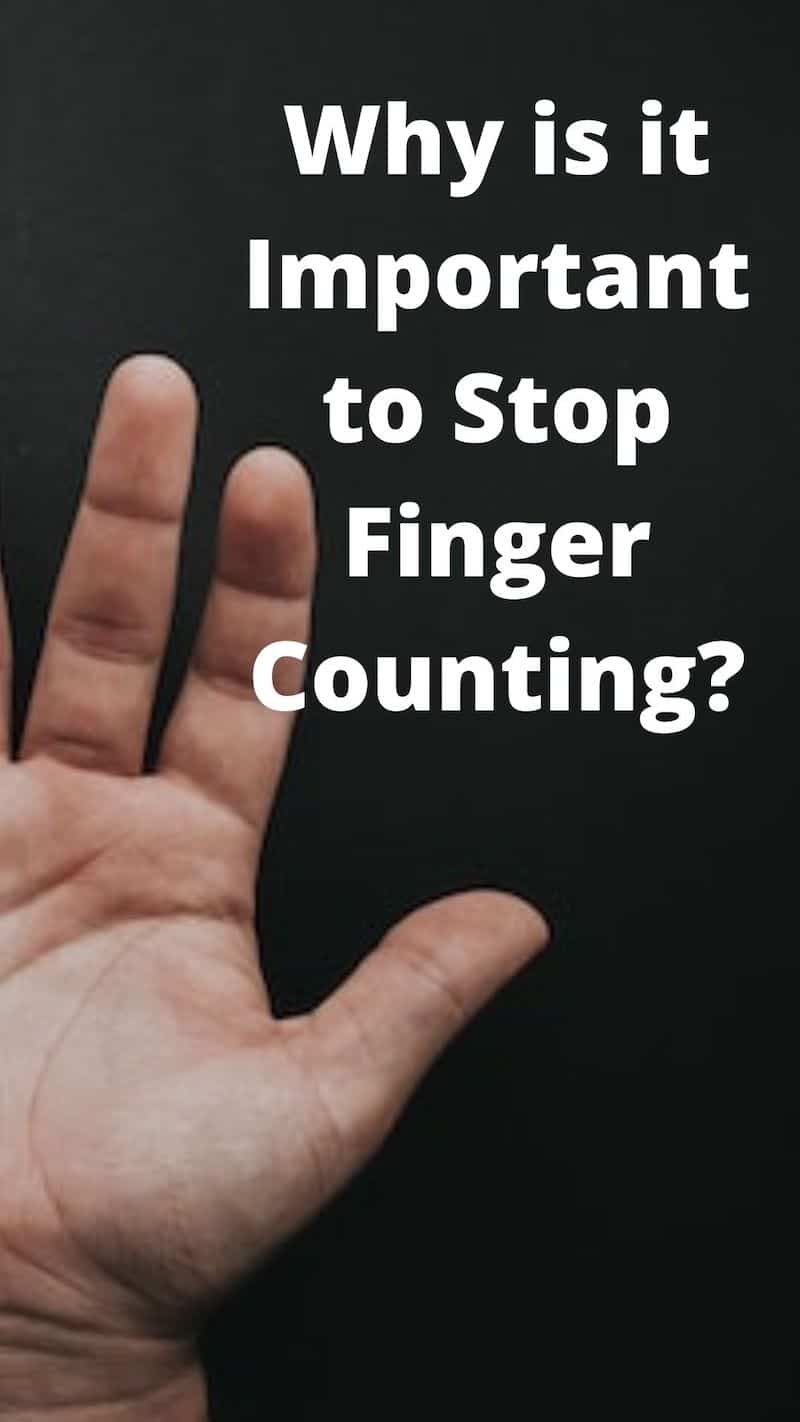Why is it important to stop finger counting?
Many teachers have a big issue that only get worse as their students grow older: finger counting. While it's okay in the younger years and usually gets ignored until later on in high school, finger counting can have a massive impact on your child's maths ability. Being aware of the issue of finger counting early on will save you many tears and frustration as your kids get older!
In this article, we will be discussing what finger counting is, why it doesn't work when learning maths, and what you can do about it.
What is finger counting?

Kids are smart. They know that when they are faced with a struggle, they will just have to find another way.
When a parent or teacher starts introducing numbers to a child, they don't have anything to link numerical characters to. What is a 3? What does it mean? How does it feel?
To substitute what isn't being taught to them in maths class, most kids start finger counting.
And it works.....
For a short time.
When kids start learning doubles and multi-digit addition, they are yet again stumped. How do you count to 48 if you only have ten fingers and ten toes?
Many kids use their fingers to count out problems, while saying the numbers aloud, in an attempt to understand what they are doing. They are trying to create a multi-sensory experience of what they are learning, and it's a great attempt!
However, maths is a language and needs to be taught like any other language. Think of the English language. When we first teach our kids words, we speak the word to them and then show them what it means, let them feel what we are referring to, and therefore create a multi-sensory experience for our child.
Consider the following:
Car.
Dog.
Chair.
Mum.
Dad.
They understand the words because they have a meaning behind it. If they want to pat the dog, they know a dog feels warm and fluffy. If they want to have Mum or Dad give them a cuddle, they know what to ask for.
Yet traditionally, maths is not taught with ANY hands-on elements. Numbers are written on a sheet of paper and the child is told "This is 3. This is 2."
How would they know what 3 is? How would they have a tactile experience of that number, without touching and feeling it in the same way they can touch and feel dog, bench, bus, Mum and Dad?
Why finger counting doesn't work
We caught up with Esther White, Director of Maths Australia to ask this important question. One of our customers in the #AskEsther section wanted to know how finger counting can impact her child, especially when they start learning number doubles and more complicated maths (past counting ten fingers and ten toes!)
Finger counting is usually linked to Place Value issues
When students struggle with recognising, adding and subtracting numbers in their heads, it is usually linked to having trouble with Place Value.
If you have to add up 42 + 36 on your fingers, how do you know which numbers are in the tens place and which numbers are in the units place? How do you know that the answer is 78, not 7+8 = 15, or 7 - 8 = 1?
It all gets very confusing, especially for young brains. Research says that children under 12 years old are developmentally unable to grasp abstract concepts - which means, they are unable to "see" something in their head without having a hands-on, concrete object to relate their understanding to.
The research on the importance of tactile learning is part of a larger group of studies on cognition and the brain showing the importance of visual engagement with math. Our brains are made up of “distributed networks,” and when we handle knowledge, different areas of the brain communicate with each other. When we work on maths, in particular, brain activity is distributed among many different networks, which include areas within the ventral and dorsal pathways, both of which are visual.
Neuroimaging research has shown that even when people work on a number calculation, such as 12 x 25, with symbolic digits (12 and 25) our mathematical thinking is grounded in visual processing. That's why at Maths Australia, we teach multiplication using a simple concept of "making a square" with the hands-on manipulatives. Once the student understands this concept, any multiplication problem is easy - they just make a square in their mind and write their answer on the page. And it's correct!
It's not only essential for maths understanding, but also for cognitive brain development to teach using hands-on manipulatives when introducing maths. Like learning a new language, maths must be touched, seen and felt to be understood properly.
What can you do about finger counting?
The same method for fixing finger counting will also contribute towards ironing out any issues with Place Value. When the student understands what numbers are, and has a direct multisensory experience of numbers, they will be able to advance further with maths.
Knowing a formula and passing the test is very different from actually understanding what, how and why you are doing in maths. When you ask a student to find the volume of a rectangular prism, they may remember the formula "base x height x length." However, when you are building a garden bed and need to fill it up with soil using the same formula, will they understand what they are doing and how to use the maths formula in everyday life?
So what is the answer?
Hands-on manipulatives.
By using specific hands-on manipulatives to teach maths concepts to your kids, you will be creating that link from concrete to abstract for them. You will be providing them with a complete understanding of numbers and how to use them.
This approach of using hands-on manipulatives will continue to serve them, from primary school to high school maths, where they will be able to create a sensory memory of numbers. Research shows that using the tactile experience of hands-on is very beneficial to overall understanding of any concept.
Neuroscientists often debate why hands-on knowledge predicts math achievement, but they clearly agree on one thing: That knowledge is critical. As Brian Butterworth, a leading researcher in this area, has written, if students aren’t learning about numbers through using their fingers to touch and feel, numbers “will never have a normal representation in the brain.”
Stopping students from using hands-on experience of numbers when they count could, according to the new brain research, be akin to halting their mathematical development. Tactile understanding through using touch is probably one of our most useful kinaesthetic and visual aids, and this "hands-on" area of our brain is used well into adulthood. The need for and importance of tactile perception could even be the reason that pianists, and other musicians, often display higher mathematical understanding than people who don’t learn a musical instrument. It's really all about including that multisensory experience into maths that concretes each concept for each child.

Want to save this article for later? Share on Pinterest.
Use these techniques to help your child stop finger counting
Now you're aware of the detrimental effects of using finger counting when learning maths, not only for younger brains and cognitive development, but also for an ongoing understanding of maths and the impact on your child's education.
By having the hands-on manipulatives as readily available tools that fix these issues and empower your child to learn maths effectively, there's no need to worry about it! By using specific tools and methodology to correct these issues, your child can, at any age, develop a stronger understanding of numbers.
If you want to see how we use these concepts in a complete program from primary to highschool maths, you can check out our maths program here. We've had thousands of parents, teachers and tutors use this program for outstanding results.
What strategies have you used to help your child stop finger counting? What has worked for you and your kids? Share in the comments below
We hope this article has been informative and useful - and given you a clear strategy to fix finger counting for your child
Warmly,
The Team at Maths Australia
